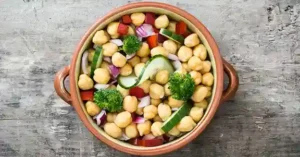Table of Contents
ToggleIntroduction to Salan Recipe Chicken
Chicken Salan is a classic Pakistani curry made with tender chicken pieces simmered in a flavorful, spiced gravy. It’s a comfort dish found in every household, known for its deep flavor and satisfying warmth. Whether you’re a beginner or a seasoned cook, this recipe brings authentic taste with simple steps. From spice lovers to curry fans, there’s something in it for everyone. Let’s dive in and learn how to make the perfect Chicken Salan at home.

Essential Ingredients for Chicken Salan
The magic of Chicken Salan begins with the right ingredients. Each element plays a specific role in creating the deep, comforting flavor this curry is known for. Here’s what you need:
Chicken
Bone-in pieces (like drumsticks or thighs) are traditionally used for richer flavor. Boneless chicken can be used for convenience, but may cook faster and result in a lighter gravy.
Onions
Sliced and deeply browned to form the flavorful base (masala). The darker the onions, the deeper the flavor of your salan.
Tomatoes
Fresh or canned, they add body, acidity, and a hint of sweetness. Cooked until oil separates — a key step in Pakistani curries.
Ginger & Garlic Paste
Essential for aroma and depth. Used early in the cooking process to infuse the oil and base.
Whole Spices
Typically include bay leaves, cloves, green cardamom, and cinnamon stick. Bloomed in hot oil to release their fragrance before adding onions.
Ground Spices
- Red chili powder heat and color
- Turmeric earthiness and color
- Coriander powder citrusy warmth
- Cumin powder nutty and bold
- Garam masala (added at the end) finishing spice for aroma
Salt
Adjusted to taste, but vital from the beginning to help the masala develop properly.
Oil or Ghee
Used generously to sauté onions and toast spices. Visible oil on top signals the salan is well-cooked.
Water
Adjusted for desired consistency — more for shorba (gravy), less for a thicker curry.

Understanding the Spices and Masala Base
The heart of any Chicken Salan lies in its masala base — the rich, spiced mixture that defines the entire flavor of the curry. Mastering this step is key to creating a salan that’s aromatic, bold, and deeply satisfying.
What Is a Masala Base?
The masala is a blend of sautéed onions, ginger-garlic paste, tomatoes, and spices. It’s cooked down slowly to develop flavor, darken in color, and thicken into a base that will later coat the chicken and flavor the curry.
Whole Spices: The First Flavor Layer
Whole spices are typically added to hot oil at the start. They infuse the oil with aroma and depth.
- Bay leaves: add a subtle earthy flavor.
- Cloves & green cardamom: bring warmth and fragrance.
- Cinnamon stick: adds a sweet-spicy note.
Tip: Let them sizzle in hot oil for 30–60 seconds until aromatic.
Onions: Caramelized for Depth
Onions are thinly sliced and fried until deep golden brown This process builds the savory backbone of the masala. Too light, and your curry will be bland. Too dark, and it may taste bitter.
Ginger-Garlic Paste: Building Aroma
Added once onions are ready. Sauté for 1–2 minutes until the raw smell disappears.
Tomatoes: The Body of the Gravy
Added after the ginger-garlic paste. Cooked down until they completely break apart and oil begins to separate. This step ensures the gravy doesn’t taste raw or overly acidic.
Ground Spices: The Main Flavor Boost
Once the tomatoes soften, it’s time for powdered spices:
- Red chili powder: for heat and vibrant color.
- Turmeric powder: for golden hue and earthy undertone.
- Coriander powder: balances the heat and adds citrusy warmth.
- Cumin powder: gives nuttiness and roundness.
- Salt: helps draw moisture from the tomatoes and intensifies the masala.
Cook these spices for 2–3 minutes, stirring constantly. Add a splash of water if they begin to stick — this prevents burning and helps the spices bloom properly.
Oil Separation: The Sign of a Ready Masala
You’ll know your masala is ready when:
The oil rises to the top and sides. The mixture thickens and becomes deeply fragrant. This is the perfect time to add your chicken and begin building the curry.

Step-by-Step Method to Make Chicken Salan
Now that your ingredients and masala base are ready, it’s time to bring everything together. Follow this detailed step-by-step method to make a flavorful, authentic Chicken Salan that’s rich, comforting, and perfect with rice or roti.
Step 1: Heat the Oil and Bloom Whole Spices
In a heavy-bottomed pot or deep pan, heat ¼ to ½ cup of oil. Add whole spices like bay leaves, cloves, cardamom pods, and a cinnamon stick. Let them sizzle for about 30 seconds until fragrant. This flavors the oil beautifully.
Step 2: Add and Brown the Onions
Add thinly sliced onions and sauté on medium heat. Stir frequently to prevent burning. Cook until the onions are deep golden brown this may take 10–15 minutes but is crucial for depth of flavor.
Step 3: Add Ginger-Garlic Paste
Add 1–2 tablespoons of ginger-garlic paste. Sauté for 1–2 minutes until the raw smell disappears and the paste blends with the onions.
Step 4: Add Tomatoes and Cook Down
Add 2–3 chopped fresh tomatoes (or canned if preferred). Cook on medium heat, stirring occasionally, until the tomatoes break down completely and oil begins to separate from the mixture. This usually takes about 10 minutes.
Step 5: Add Ground Spices
Stir in your ground spices:
- 1 tsp red chili powder (adjust to taste)
- ½ tsp turmeric powder
- 1 tsp coriander powder
- 1 tsp cumin powder
- Salt to taste
Cook the mixture for 2–3 minutes, adding a splash of water if needed to prevent sticking. This step intensifies the masala and gives your salan its signature bold flavor.
Step 6: Add the Chicken
Add bone-in or boneless chicken pieces (approx. 1–1.5 kg). Stir well to coat each piece in the masala. Sauté the chicken for 5–7 minutes until it changes color and starts to seal in the flavor.
Step 7: Add Water and Simmer
Add enough water depending on your preferred consistency:
- 1.5 to 2 cups for a thick curry
- 3 to 4 cups for a thin, shorba-style gravy
Bring to a boil, then cover and simmer on low heat for 25–30 minutes, or until the chicken is cooked through and tender.
Step 8: Add Finishing Spices
Once the chicken is tender, check seasoning. Add ½ tsp garam masala and stir gently. Simmer uncovered for a few minutes to let flavors concentrate. Optionally, increase heat to bhunofy (reduce and roast) the gravy slightly if a thicker consistency is desired.
Step 9: Let the Oil Rise
Once the gravy is done, you should see a thin layer of oil rising to the top — a sign your Chicken Salan is perfectly cooked and ready to serve.

Using Tools: Blenders, Processors & Pro Tips
While Chicken Salan is a traditional dish, using modern kitchen tools can help you save time and perfect the texture of the gravy. This section covers the smart use of tools like blenders and food processors — plus expert tips that elevate your salan from good to unforgettable.
Using a Food Processor: Save Time on Prep
Chopping onions, tomatoes, and herbs manually can be time-consuming. A food processor helps you quickly and evenly chop onions and tomatoes, ensuring they cook uniformly. For even faster prep, pulse onions coarsely — but don’t over-process them into a paste, or they may release too much water.
- Tip: Use separate batches for onions and tomatoes to control texture better.
Immersion Blender: Smooth and Silky Gravy
For those who prefer a smooth, restaurant-style curry, an immersion (hand) blender is your best friend. Once your masala is cooked (after tomatoes and spices are added), you can briefly blend it directly in the pot for a smoother gravy. This helps break down onion and tomato bits, giving you a rich, cohesive base.
- When to blend: Before adding chicken once masala is fully cooked and oil has separated.
Regular Blender: For Batch-Blending Masala
If you don’t have an immersion blender, you can cool the masala slightly and blend it in a regular countertop blender. Make sure to blend in small batches and never seal a hot mixture tightly, as steam buildup can be dangerous. Return the blended masala to the pot, then proceed with adding the chicken.
Pro Tip 1: Don’t Rush the Oil Separation
One of the most common mistakes is undercooking the masala. Always wait until oil separates from the masala, which signals full flavor development. If oil hasn’t risen, keep cooking on medium-low heat — patience pays off in flavor.
Pro Tip 2: Layer Flavors with Bhunai
“Bhunai” refers to sautéing the masala and chicken together at high heat to deepen flavor and reduce water content. Once the chicken is added, sauté it for 5–10 minutes before adding water. You’ll notice the gravy turns thicker, darker, and more intense.
Pro Tip 3: Use Warm Water for Better Gravy
When adding water to your curry, use warm or hot water instead of cold. This keeps the temperature consistent and helps maintain the cooking momentum, especially important when cooking on low heat.
Pro Tip 4: Taste and Adjust at the End
Before turning off the heat, always taste for salt, spice, and richness. Add a pinch of garam masala or squeeze of lemon for a final flavor boost if needed.

Boneless vs Bone-in Chicken Options
One of the first decisions you’ll make when preparing Chicken Salan is choosing between boneless and bone-in chicken. Each option offers different textures, cooking times, and flavors. Here’s a detailed comparison to help you pick the right one for your needs.
Bone-in Chicken: Traditional and Flavorful
Why it works:
Bone-in pieces (like thighs, drumsticks, or leg quarters) are commonly used in traditional Pakistani Chicken Salan. Bones release natural juices and collagen as they simmer, which enriches the gravy and deepens the flavor.
Benefits:
- Rich, full-bodied gravy
- Juicier meat that stays tender even after longer cooking
- More authentic texture and presentation
Drawbacks:
- Longer cooking time (about 30–40 minutes)
- May require effort while eating (removing bones)
Best for: Family dinners, traditional meals, and when flavor is the top priority.
Boneless Chicken: Quick and Convenient
Why it works:
Boneless chicken (especially breast or boneless thigh pieces) is perfect for faster cooking and easier eating. It absorbs masala flavor well and works great for meal prep or everyday use.
Benefits:
- Cooks quickly (15–20 minutes)
- Easier to serve and eat
- Great for wraps, salads, or leftovers
Drawbacks:
- Can dry out if overcooked
- Less rich gravy compared to bone-in
Best for: Weeknight meals, kids, or guests who prefer boneless meat.
Flavor Tip: Use Chicken Thighs If Going Boneless
Boneless thighs offer the best of both worlds — faster cooking and more juiciness than breast meat. They stay tender and flavorful even if simmered a bit longer in the gravy.
Adjusting the Cooking Time
- Bone-in chicken: Simmer for 25–35 minutes, depending on size and cut.
- Boneless chicken: Simmer for 15–20 minutes to avoid drying out.
Hybrid Option: Mix Both
Some cooks use a combination of bone-in and boneless pieces for balanced texture and flavor. This approach is ideal when cooking for a group with different preferences.

Finishing Touches & Garnishing
The final steps of preparing Chicken Salan are just as important as the cooking process. These finishing touches bring harmony, balance, and visual appeal to the dish. They also allow you to adjust and perfect the flavor before serving. Here’s how to wrap up your salan with professional polish:
Check the Gravy Consistency
Once the chicken is fully cooked and tender, take a moment to check the thickness of the gravy. For a traditional shorba-style salan, the gravy should be thin but flavorful. If you prefer a thicker curry, increase the heat and simmer uncovered for a few minutes until it reduces to your liking.
Add Garam Masala for Aroma
Sprinkle ½ to 1 teaspoon of garam masala into the curry just before turning off the heat. This spice blend adds warmth and complexity without overpowering the dish. Let it simmer for 1–2 minutes after adding garam masala to fully release its aroma.
Final Salt & Spice Adjustment
Always taste the salan before serving. Adjust salt, chili, or lemon juice based on your preference. A small pinch of black pepper can also lift the overall flavor if needed.
Garnish for Freshness and Color
Top your Chicken Salan with any of the following to brighten up the dish:
- Fresh chopped coriander (cilantro): Adds color and a herby aroma.
- Sliced green chilies: Gives a fresh, spicy kick and enhances the traditional look.
- Julienned ginger: Offers a zesty contrast and a light crunch.
- A drizzle of ghee or melted butter (optional): Adds richness and shine for a special touch.
Let It Rest (Optional but Helpful)
If time allows, let the salan rest for 10–15 minutes after cooking. This gives the flavors time to meld and allows the oil to rise to the top — a sign of a well-made curry. Reheat gently if needed before serving.
Serving Bowl Presentation
Serve Chicken Salan in a wide, deep dish or handi-style bowl. Spoon some of the oil over the top for an inviting, glossy finish. Add garnishes just before serving to keep them fresh and vibrant.

Variations and Add-ons
While the classic Chicken Salan is delicious on its own, you can easily tailor it to your taste, regional preferences, or available ingredients. This section explores popular variations and flavorful add-ons to customize your curry and keep it exciting every time you make it.
Potato Chicken Salan (Aloo Chicken)
A popular household variation. Add medium-sized potato chunks when the chicken is halfway cooked. Potatoes soak up the masala, making the dish heartier and more comforting. Cut potatoes evenly so they cook at the same rate as the chicken.
Chicken and Egg Curry
Hard-boiled eggs are added during the final 10 minutes of cooking. Slit the eggs lightly before adding so they absorb the masala. Great for guests or when you want to stretch the meal.
Yogurt-Enhanced Salan
Add 2–3 tablespoons of whisked yogurt to the masala after tomatoes have softened, before adding the chicken. Yogurt adds creaminess, tang, and a slightly thicker consistency. Stir well to prevent curdling.
Coconut Chicken Curry (Fusion Style)
Add ½ cup coconut milk toward the end of cooking for a rich, mild variation. This version works especially well with boneless chicken and pairs nicely with rice.
- Optional: Add curry leaves and mustard seeds for a South Asian fusion twist.
Green Chicken Salan (Hari Mirch Version)
Replace red chili powder with green chili paste and add fresh coriander and mint while blending the masala. This results in a bright green, herby curry with a fresh kick. Perfect in summer and pairs well with paratha or boiled rice.
Spicy Smoky Chicken Salan
After cooking, place a small piece of hot charcoal in a bowl in the pot. Drizzle a drop of oil or ghee on the coal and cover the pot for 2–3 minutes. This gives the curry a smoky aroma like restaurant-style handi chicken.
Butter Chicken Salan (Rich & Creamy)
Stir in a small cube of butter and 2 tablespoons of cream near the end. This adds a luscious richness and tames the spice for a milder version. Ideal when serving guests or kids.
Vegetable Additions
Add peas, capsicum, or spinach for extra nutrition and variety. These can be added halfway through the cooking time, depending on the vegetable.
Low-Oil Version
Reduce the oil used in the masala and skip the final oil garnish. Use non-stick cookware to prevent sticking, and add small splashes of water to prevent burning. The flavor will be lighter but still satisfying if spices are properly bloomed.
Make-Ahead or Freezer-Friendly Salan
Chicken Salan freezes well and can be made ahead for busy weeks. Let it cool completely, store in airtight containers, and freeze for up to 1 month. Thaw and reheat on the stove, adding a splash of water if needed.

How to Serve Chicken Salan
A well-made Chicken Salan deserves to be served with the right sides and in the right way to complete the meal. Whether it’s a family dinner or a festive gathering, the way you serve it can elevate both the flavor and the experience. Here’s how to serve Chicken Salan like a pro:
Best Accompaniments
Steamed Basmati Rice
The most traditional and popular pairing. The fluffy rice soaks up the flavorful salan (gravy), making each bite satisfying and balanced. Serve with a wedge of lemon for brightness.
Roti or Chapati
Soft flatbreads are ideal for scooping up the gravy and tender chicken. Best served warm and fresh off the tawa (griddle).
Naan or Paratha
For a richer meal, serve with butter naan or layered paratha. Ideal for dinner parties or special occasions.
Jeera (Cumin) Rice or Peas Pulao
Adds a bit more flavor than plain rice. Pairs well if your Chicken Salan has a thin, shorba-style gravy.
Side Dishes to Complement the Meal
Kachumber Salad
A fresh salad of cucumbers, onions, tomatoes, and green chilies with a squeeze of lemon. Balances the richness of the curry.
Raita or Yogurt
Cools the palate and complements the spices. Try plain yogurt, cucumber raita, or mint raita.
Achar (Pickle)
Adds tang and spice to the meal. Especially good when served with rice or roti.
Papad or Fried Green Chilies
Offers texture and a crispy side element.
Serving Tips for Presentation
- Use a deep serving bowl or handi: It keeps the salan hot and helps retain moisture.
- Garnish just before serving: Sprinkle chopped coriander, green chilies, or a drizzle of oil/ghee for visual appeal.
- Serve hot: Chicken Salan should be served piping hot so the gravy remains silky and inviting.
How to Serve for Guests or Gatherings
Place Chicken Salan in a centerpiece dish and surround it with rice, bread, and condiments. Offer both bone-in and boneless options if serving a crowd. Label spice levels or keep yogurt-based sides nearby for balance.
Leftover Serving Ideas
- Wraps: Use leftover chicken and gravy in paratha or roti wraps.
- Chicken Salan Pulao: Mix the leftover salan with boiled rice for a quick one-pot meal.
- Salan Sandwiches: Shred the chicken and serve in toasted buns with chutney or yogurt.

Final Tips & Notes for the Perfect Salan
Making Chicken Salan is not just about following a recipe — it’s about understanding the process and developing the right instincts. This final section wraps up the most valuable tips and key notes to help you consistently achieve a flavorful, well-balanced curry every time you cook.
Don’t Rush the Masala Cooking
Take your time when sautéing onions and cooking down tomatoes. This step builds the foundation of your curry’s flavor. Wait for oil to separate from the masala before proceeding to the next step — it’s a sign that your base is cooked properly.
Taste As You Go
Regularly taste for salt, spice, and balance throughout cooking. Don’t be afraid to adjust chili, salt, or tang (with tomatoes or lemon) near the end.
- Remember: gravy always intensifies in flavor as it sits.
Use Fresh Ingredients for Best Flavor
Fresh onions, tomatoes, and ginger-garlic paste bring more aroma and natural sweetness than packaged versions. If using store-bought pastes, opt for high-quality brands with no added fillers.
Adjust Gravy Consistency Based on Preference
For shorba-style (runny) curry, add more water and simmer gently. For a thicker, richer curry, reduce water and allow it to cook uncovered near the end. Stir occasionally to prevent sticking, especially when reducing the gravy.
Always Finish with Garnish and Rest Time
A sprinkle of garam masala, fresh coriander, or a few green chilies adds a final burst of flavor. Letting the curry rest for 10–15 minutes after cooking allows the flavors to settle and deepen. Reheat gently before serving, if needed.
Use the Right Pan
A heavy-bottomed pot or karahi distributes heat evenly and prevents burning. Avoid thin or lightweight pans that can cause the masala to stick and scorch.
Store Leftovers Properly
Refrigerate in an airtight container for up to 3 days. Freeze for up to 1 month. Thaw overnight in the fridge and reheat on the stove. The flavors often taste even better the next day!
Make It Your Own
Chicken Salan is incredibly versatile. Don’t hesitate to experiment with:
- Spice levels
- Additional ingredients like eggs, vegetables, or yogurt
- Garnishes and presentation
Conclusion
Chicken Salan is a timeless dish that captures the essence of Pakistani home cooking — simple ingredients, layered spices, and soulful comfort. With the right techniques, attention to detail, and a few smart tips, you can turn everyday chicken into a rich, flavorful curry that brings people together. Whether served with rice, roti, or naan, this versatile salan is sure to become a favorite at your table. So roll up your sleeves, follow the steps, and enjoy the rewarding experience of cooking a truly authentic Chicken Salan at home.
FAQS

Salan Recipe Chicken
Ingredients
- 1.5-2 lb bone in chicken or 1.5 lb boneless
- ⅓ cup oil
- 1 small piece cinnamon stick
- ½ tsp cumin seeds
- 5-6 whole black peppers
- 2-3 laung cloves
- 3 diced onions approx 350g
- 2 diced tomatoes between 210-220g
- 1.5 tsp garlic paste
- 1 tsp ginger paste
- 1 ¼ tsp salt
- ¾ tsp red chili powder
- ½ tsp kashmiri laal mirch optional, but gives great colour and a mild spice
- 1 ½ tsp coriander powder
- ¼ tsp turmeric powder
- ½ tsp garam masala
- ½ tsp cumin powder
- chopped cilantro
- 2-3 sliced green chilies
Method
- Heat your oil in a large pot on medium high heat
- When it shimmers then add the whole spices i.e cinnamon, cumin seeds, cloves, and whole black peppers.
- After the cumin seeds start to sizzle and smell delicious then add the onions
- When the edges of the onion turn golden then add the garlic paste and ginger paste and sauté for 30 seconds.
- Now stir in your tomatoes and spices. Cover the pot and turn the heat down a little to medium heat for 2-3 minutes - this speeds up the process of cooking the masala.
- Turn the heat back up, remove the lid and sauté the spice mix until the oil rises above the top.
- Use an immersion blender to make the salan into a mostly smooth paste, you will need to tilt the pot to make this happen.
- Add your chicken pieces to your pot stirring periodically until all of the chicken turns white/opaque
- Now add ½ cup of water to your pot if the masala seems very bring to a boil and simmer on low until the chicken is cooked through, 15-20 minutes.
- Adjust the consistency of the salan to your liking, add the garam masala powder and cumin powder, then adjust seasoning.
- Garnish with cilantro and green chilies and serve.
